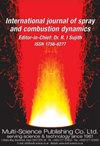不同预蒸发度稀薄旋流喷雾火焰的稳定性和结构
IF 2.1
4区 工程技术
Q3 ENGINEERING, MECHANICAL
International Journal of Spray and Combustion Dynamics
Pub Date : 2023-03-15
DOI:10.1177/17568277231159173
引用次数: 0
摘要
在贫预汽化预混合燃烧器中实现充分预混和完全蒸发是一项挑战,因为这取决于喷雾器的特性、预汽化策略和流动条件。本文通过实验研究了不同预汽化程度下湍流旋流正庚烷喷雾火焰的稳定性和结构。结果表明:将空气预热至343 K和393 K对稀薄排气速度影响不大,而减小喷油量可显著降低稀薄稳定性极限;为了关联这些限制,进行了各种尝试来定义Damköhler数字,但与以前没有预蒸发的研究不同,在本例中定义层流火焰速度的困难不允许单一相关性适用于所有程度的预蒸发。利用一维PDA、OH*化学发光和ch2o平面激光诱导荧光(PLIF)技术研究了等效比、空气预热温度和燃油喷射间隙不同的4种稳定工况。在没有燃油喷射凹槽或空气预热的情况下,在剪切层附近出现锥形的放热区。将空气预热到393 K,减少了Sauter平均直径,增加了预蒸发,并使燃油喷射下游的第二个热释放区成为可能。将燃油喷射深度缩小25mm可降低液滴速度,并导致半球形热释放区而不是锥形热释放区。无注射凹槽的ch_2 O-PLIF信号沿中轴高,其分布与喷射火焰相似。相比之下,凹喷喷射时,ch2o主要出现在中央再循环区外,仅在贫吹时出现在中心再循环区内;类似于之前预混火焰的工作。这些结果表明,不同的预蒸发方法对火焰稳定性有很大的影响,而这些预蒸发方法只在液滴特性上有细微的变化。目前的数据可以用于紊流火焰建模,重点是喷雾和有限速率动力学。本文章由计算机程序翻译,如有差异,请以英文原文为准。
Stability and structure of lean swirling spray flames with various degrees of prevaporization
Achieving full premixing and complete evaporation in lean prevaporized premixed combustors is challenging as it depends on the spray injector characteristics, prevaporisation strategy, and flow conditions. This article experimentally explores the stability and structure of a turbulent swirling n-heptane spray flame under various degrees of prevaporization. The results show that preheating the air to 343 K and 393 K has little effect on the lean blow-off velocity, while recessing the fuel injection significantly decreases the lean stability limit. To correlate these limits, various attempts to define a Damköhler number were made, but unlike previous studies with no prevaporisation, the difficulty in defining laminar flame speed in the present case does not allow a single correlation to work for all degrees of prevaporization. Four stable cases that differ in equivalence ratio, air preheat temperature, and fuel injection recess are investigated using one-dimensional PDA, OH* chemiluminescence and CH 2 O-planar laser-induced fluorescence (PLIF). Cases without fuel injection recess or air preheat exhibit a conical-shaped heat release zone near the shear layers. Preheating the air to 393 K reduced the Sauter mean diameter, increased prevaporization, and enabled a second heat release zone downstream of the fuel injection. Recessing the fuel injection by 25 mm reduced droplet velocities and led to a semi-spherical instead of a conical heat release zone. The CH 2 O-PLIF signal without injection recess was high along the central axis and its distribution resembled that observed for spray jet flames. In contrast, with recessed spray injection, CH 2 O was mainly found outside the central recirculation zone and only appeared inside during lean blow-off; similar to previous work with premixed flames. These findings show that different methods of prevaporization, which only differ by subtle changes in droplet characteristics, strongly impact flame stability. The present data can be used for turbulent flame modelling focusing on sprays and finite-rate kinetics.
求助全文
通过发布文献求助,成功后即可免费获取论文全文。
去求助
来源期刊

International Journal of Spray and Combustion Dynamics
THERMODYNAMICS-ENGINEERING, MECHANICAL
CiteScore
2.20
自引率
12.50%
发文量
21
审稿时长
>12 weeks
期刊介绍:
International Journal of Spray and Combustion Dynamics is a peer-reviewed open access journal on fundamental and applied research in combustion and spray dynamics. Fundamental topics include advances in understanding unsteady combustion, combustion instability and noise, flame-acoustic interaction and its active and passive control, duct acoustics...
 求助内容:
求助内容: 应助结果提醒方式:
应助结果提醒方式:


